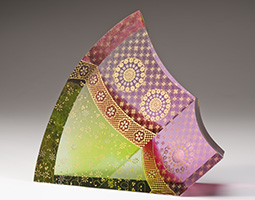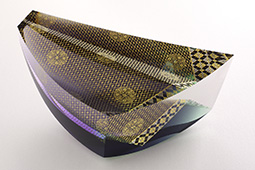November 2022
- English
- 日本語
Traditional Patterns of Gold Suspended in Glass

“Hitohabune” (Leaf Boat) by Yamamoto Akane (British Museum collection) (H: 5.8 cm x W: 27.8 cm x D: 8.9 cm) 
Chapter 45, “Hashihime” (character’s name), from the Genji Monogatari series by Yamamoto Akane (personal collection) (H: 11.3 cm x W: 49.5 cm x D: 10.8 cm)

Yamamoto Akane 
Chapter 24, “Kocho” (character’s name), from the Genji Monogatari series by Yamamoto Akane (personal collection) (H:24.4cm x W: 27.0cm x D: 9.1cm) 
Chapter 3, “Utsusemi” (character’s name), from the Genji Monogatari series by Yamamoto Akane (personal collection) (H: 19.0 cm x W: 44.0 cm x D: 24.0 cm)

Yamamoto Akane has developed a new and original field of art known as “Kirikane Glass,” which involves forming various patterns using the age-old kirikane decorative technique and encasing them in glass. Suspended in the glass, the delicate traditional patterns radiate a golden glow.

Kirikane is a decorative technique for creating patterns that involves pasting together thin layers of gold leaf or other metals. The technique is highly delicate. Several layers of gold, silver, platinum, or other foils are cut into strips finer than a human hair, or squares measuring a few millimeters across, and then brushed with glue and adhered together to produce exquisitely detailed patterns. The tradition dates back to antiquity and was originally used to decorate Buddhist image sculptures and paintings with solemnity. Kirikane Glass, in which kirikane patterns are encased in glass, is a new field of art established by Yamamoto Akane. Yamamoto is from Kanazawa City, Ishikawa Prefecture, and studied Nihonga (traditional Japanese painting) at Kyoto City University of Arts. Being fascinated with kirikane during her time as a student replicating Buddhist paintings, she became apprenticed to Eri Sayoko (1945–2007), a kirikane master who would become a holder of Important Intangible Cultural Property (commonly referred to as a Living National Treasure) while still a student.
After acquiring the kirikane technique, Yamamoto was motivated by her desire to “create works in which kirikane plays the leading role, not as a decorative element.” In the process of experimenting with different forms of expression through trial and error, Yamamoto came up with the notion of somehow suspending the kirikane itself in space. Her initial attempts proved unsuccessful because gold leaf* and other kirikane materials are very thin and tear easily, making it difficult to fix the patterns in place. The solution she came up with was to encase the kirikane in clear glass. In fact, Yamamoto was self-taught in glass making at the time, but to acquire more specialized skills, she enrolled in the Toyama Institute of Glass Art, where she learned about glass from the basics.

Kirikane Glass was the result of these efforts. Kirikane Glass is made by applying kirikane on casted glass. This is then topped with additional glass and reheated and fused together, giving the kirikane the appearance of being “suspended” in the glass. The process is, however, fraught with challenges, and the artist must remain attentive at every step until completion of the final work. If the temperature of the kiln is not right, or if the heat is not monitored during the cooling process, kirikane designs can warp or melt, and further the glass can shatter while polishing. Works that take more than a year to complete sometimes fail at the final stage. Nevertheless, Yamamoto continues to make kirikane glass in spite of such challenges because she is moved and inspired by her own work.
“No matter how carefully I calculate beforehand, the appearance of a finished kirikane piece may turn out to be beautiful but quite different from what I had expected, so much so that it makes me wonder if God has cast a spell on it. When that happens, the difficult process I’ve gone through is instantly forgotten and I feel inspired to begin working on the next new piece right away.”

Yamamoto says that she is continually coming up with new ideas for the works she wants to produce. Among them is her life work consisting of a series of pieces based on the world of Genji Monogatari (“The Tale of Genji”)** written by Murasaki Shikibu at the beginning of the 11th century in the mid-Heian period (late 8th century to late 12th century), when dynastic culture flourished.
Yamamoto’s passion for the series is evident when she says, “I feel the presence of an elegant beauty in both Genji Monogatari, which portrays the court culture of the Heian period, and kirikane, which was widely used around the time the book was written. In keeping with my former ambition of becoming a Nihonga artist to draw my own Genji Monogatari, I want to express memorable scenes one by one from each of the 54 chapters of Genji Monogatari.”

The world of Kirikane Glass is produced by the hands of Yamamoto Akane. She alone is able to express that world. “In the absence of a mentor, my only guide is Genji Monogatari,” she says.
The works that Yamamoto has produced since opening her own studio in Kyoto in 2011 have garnered numerous awards. She has also received worldwide recognition, with her work “Hitohabune” (Leaf Boat) being acquired by the British Museum in London in 2019.
The appeal of Yamamoto’s work is that the kirikane takes on a variety of expressions depending on the position and angle from which it is viewed, as well as on the amount of light that shines through the glass. Many people are captivated by the golden light that emanates through the glass from the kirikane. During the Heian period, kirikane was primarily employed as a decorative technique for Buddhist image sculptures. Today, Yamamoto has brought it center stage, where it may provide comfort to those who view it as did Buddhist image sculptures of that time.
* See Highlighting Japan October 2022, “Kanazawa Gold Leaf” https://www.gov-online.go.jp/eng/publicity/book/hlj/html/202210/202210_06_en.html
** Completed in the early 11th century. The first half of the novel depicts the glamorous lifestyle of the nobility, including the protagonist Hikaru Genji, while the second half focuses on the love of his son, General Kaoru.

